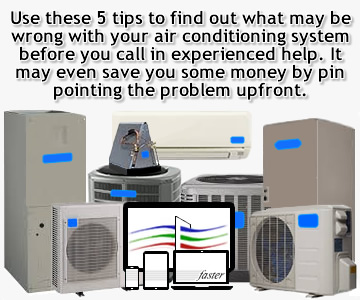Air conditioning system not cooling properly or working at all? There are some simple steps you can take before contacting the professionals. It could save you time and money. You could even learn a few things about your air conditioning system in the process.
This diagnosis works on central split-system air conditioning and heat pumps in cooling mode.
It is important that you follow these steps in order.
Shut the air conditioning system down.
Determine what part of the system is working. There is an indoor unit (evaporator) and an outdoor unit (condenser). The indoor evaporator's refrigerant coil may have its own unit (air handler) or used with a furnace's fan (blower). At the thermostat turn the "COOL" switch to "OFF" and the "FAN" switch to "AUTO". The system should shut down. Some systems have a time delay, but should shut off in a few minutes. If the system does not shut off in 10 - 15 minutes, make sure you are controlling the right thermostat to the system. Proceed to the next step even if the indoor system continues to run or has shut down.
Turn off power to all air conditioning units.

Find the electrical breakers to the units and switch both the outdoor and indoor units to the "OFF" position. The indoor unit's breaker may be to an air handler or a furnace. The outdoor unit will be to a two breaker (double-pole) switch. The indoor unit may be to either a single or double-pole switch. Both systems should be completely shut down now. If a unit is still running, you are not switching off the correct breaker. You may have to switch off breakers until you find the right one. Once you find the right one, label it. You can find Electric Testers here.
Note: If you find the electrical breakers to one or both units are tripped, continue to put them to the "OFF" position. DO NOT turn the breakers to the "ON" position at this step in the diagnosis! Continue to the next step.
Check for icing and dirty filter.

Go to the indoor unit. Is there water coming from the unit onto the floor or into an exterior drain pan? Is there ice formed on the unit, refrigerant pipes, or duct work? Remove the indoor unit's air filter and check to see if it is dirty. Is it wet? If ice or water leakage is visible, you will need to wait until the ice melts before replacing the old air filter and continuing to the next step. DO NOT try to pick off the ice! You can cause a refrigerant leak! You can place towels around the unit to catch the water. There may be a lot of water before it's all melted! Once the ice has melted and the water is dried, you can install a new, clean filter and proceed to the next step.
Isolate the problem to the indoor unit.

Turn on the electrical breaker for the indoor unit ONLY. At the thermostat, turn ONLY the "FAN" switch to "ON". The indoor unit should come on. If the indoor unit does not come on with both the electrical breaker and the thermostat "FAN" set to "ON", this is where the problem is. The system should be serviced at the air handler or furnace blower to find out why it is not working. If the indoor unit does come on, go to an air vent that you know has good air flow and feel if there is air coming out of it. If little or no air is coming from the vent: A. The ice may not be completely melted. B. The indoor coil (evaporator) is dirty (clogged). C. The blower (fan) motor is not working properly. D. There is a low or high voltage (electrical) problem causing the indoor unit not to run properly. If the indoor unit is not producing normal air flow or is not operating, you have isolated the problem to the indoor unit. If there is normal air flow coming from the vent, proceed to the next step.
Isolate the problem to the outdoor unit.

Turn on the electrical breaker to the outdoor (condensing) unit. Both electrical breakers for the indoor and outdoor unit should be now. At the thermostat, turn the "FAN" switch from "ON" to "AUTO" and from "OFF" to "COOL". Adjust the temperature setting to 10 or more degrees below the room's temperature. Does the outdoor unit come on? If so, wait about 10 minutes and check it again. Is it still on? Check the same air vent mentioned before. Is the air getting cooler? If the outdoor unit does not come on, or runs then shuts off, the air doesn't seem to be getting cooler, or the indoor room temperature doesn't start to cool down; there are issues with the outdoor unit that need to be addressed. You have isolated the problem to the outdoor unit. This is where troubleshooting the system should begin.
In conclusion.
There is a reason why you need to do these steps in order. Most air conditioning systems need to go through a "reset" before you can find where the problem is occurring. Refrigerant pressures need to balance. Circuit boards, relays, and sensors need to be restarted. For some of you this may even help the system to start working again. With this said ask yourself, "What caused the system to stop working?" We hate to be the bearer of bad news, but most likely the air conditioning problem will happen again. You can not keep resetting your system when it stops cooling. It could actually cause more problems within the system or cause other air conditioning parts to fail prematurely. Have your air conditioner checked to make sure the problem is repaired, so you will continue to have cooling all season long.

